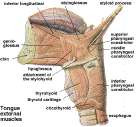Articulation:Tongue
The tongue is the most important articulator of speech. This muscle is extremely strong, as it must move food around in our mouths as we chew. Its other biological function is to push the food into a bolus (I prefer the less scientific term "glob"), and then push it down the oesophagus to our stomach. Try swallowing to feel the strength of your tongue pushing down and back. Speech, on the other hand, requires a very different approach. For the sound to resonate effectively, the less tongue root tension (i.e. tension in the extrinsic muscles of the tongue), the better. For speech you want to relax the tongue up and forward, the opposite of swallowing. The quick movements of the tongue, necessary for rapid delivery of tongue twisters for example, require very delicate control of the action of the tongue. This control is often best regulated in concert with the ear, listening to the sounds created by the voice when the tongue is in one position over another. Sensitivity is the key to learning to appreciate the range of capabilities the tongue possesses.
Landmarks:
-
Tip, front edge, blade, middle, back of tongue
-
Median fibrous septum
- Eight muscles of the tongue, divided into intrinsic & extrinsic muscles
Tip:
- the very point of tongue
Front edge:
- awareness is essential for delicate control of alveolar plosives, such as /t, d/
Blade:
- that part that is free to flap up and down, the front third
Middle:
- just behind the blade
Back:
the surface of the tongue begins to change here; awareness is important for certain back vowels
Median Fibrous Septum: Medianibrous Septum:
- a divider that runs down the centre of the tongue serves as an attachment for the transverse muscles.
Intrinsic Muscles of the Tongue:
 The
image at left features the important muscles of the body of the tongue. The
transverse muscle fibers are hard to see because they can only be seen in
cross-section as little dots running under the longitudinal muscles. Also
visible in this image is the genioglossus, which joins the tongue to
the chin and the geniohyoid, which joins the chin and hyoid bone.
The
image at left features the important muscles of the body of the tongue. The
transverse muscle fibers are hard to see because they can only be seen in
cross-section as little dots running under the longitudinal muscles. Also
visible in this image is the genioglossus, which joins the tongue to
the chin and the geniohyoid, which joins the chin and hyoid bone.
Inferior and Superior Longitudinal Muscle:
- go the length of the tongue
- moves tip up and down
Transverse Muscle:
- go across the tongue
- narrows and lengthens the tongue
Vertical Muscle:
- go up and down in the tongue
- flattens and depresses the tongue
 This
side view of the extrinsic muscles gives and excellent idea of how big the
"roots" of our tongues are. You can feel these muscles by pressing
a fingertip under your chin, up towards the tongue. Those muscles should be
soft and gooey, especially during phonation.
This
side view of the extrinsic muscles gives and excellent idea of how big the
"roots" of our tongues are. You can feel these muscles by pressing
a fingertip under your chin, up towards the tongue. Those muscles should be
soft and gooey, especially during phonation.
Genioglossus: chin to tongue
- sticks out the tongue
- presses against the teeth or alveolar ridge
- pulls the tongue tip back
- troughs the tongue
Styloglossus: styloid process behind ear to tongue
- pulls the tongue upward and back
Palatoglossus: palate to tongue
- pulls the tongue back to grove the tongue
Hyoglossus:hyoid bone to tongue
- retracts or depresses the tongue
- elevates the hyoid bone
-
Tongue (on this page)
-
intrinsic muscles
-
extrinsic muscles
-
-
-
Hard Palate
-
Soft Palate
-
Back to Articulation
Back to The Journey of the Voice
More on Articulation:
Master
Muscle List
Loyola University has a great online learning area on anatomy. This link
puts you in the Master Muscle List by Region, where you should select
"head and neck". This will give you a huge long list of all
the muscles in the head and neck which you can use to learn more about
these structures.

